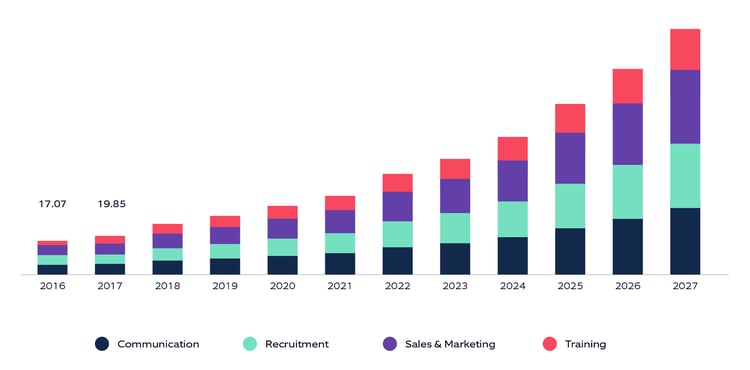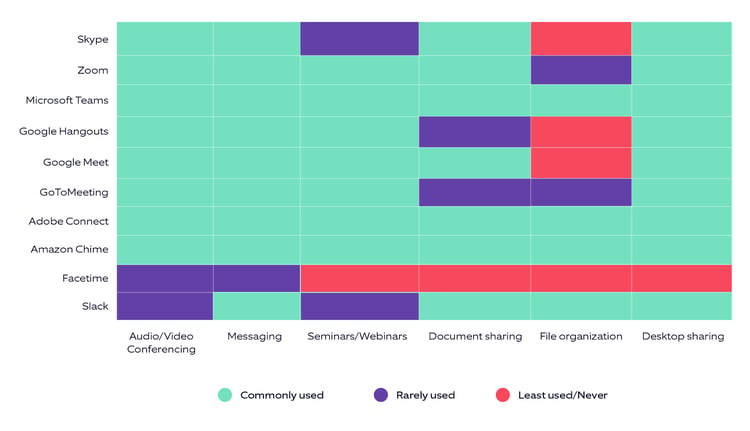Who would have thought that the way we interact will undergo such a paradigm shift and will become the new normal? Be it education, birthday celebrations, client workshops or family gatherings, everything has navigated from the physical to the virtual landscape.
Technology has now been in place for long enough to support virtual events; however, in-person events are always preferred because of the common notion that they are more interactive. Well, like it or not, last year’s Coronavirus crisis has turned the tables completely, impelling brands to navigate to the virtual event landscape. To quote just one of the many such examples, Salesforce World Tour Sydney Reimaged was one of the biggest events that was streamed online instead of through their regular, in-person format and was quite successful. Virtual platforms have now started filling the gaps in the best possible manner. According to a survey, the market size of global virtual events was valued at USD 77.98 billion in 2019 and it is expected to grow at a CAGR of 23.2% from 2020 to 2027.

Increased presence of virtual platforms
The days when virtual platforms were used to only make video calls are now passé. We have come a long way now. Today, virtual platforms can be used in different modes for video conferencing, webinars, broadcasting and live streaming, content streaming, screen sharing, recording, etc. These modes are used independently in some platforms and in a hybrid way in others.
According to a virtual events platform report, virtual events are up by 1,000% post-COVID! But are you ready to make the most of this virtual wave? In this blog, we will discuss some critical aspects of virtual platforms to support such events successfully.
Essential features of virtual platforms
In this ever-evolving world of technology, many virtual event platforms have tried to carve a niche for themselves. However, when it comes to technology, everything is in a constant flux as there is always room to make updates with new features.
Let us look at some essential features of virtual platforms, including those that have already become indispensable:
1. Event management
Conducting an event on a virtual platform demands life cycle support. Virtual event platforms offer a complete package comprising features that can facilitate event management’s basic life cycle. Users prefer transactions that happen at the click of a button. Therefore, processes such as event registrations, ticket access, cancellations, feedback, payments, troubleshooting, etc. must become an inherent part of such platforms.
Nagarro has developed a multi-faceted virtual platform with varied roles, providing all event management modules and making the platform a one-stop-shop for diversified features.
2. Live streaming and content play
Broadcasting is the backbone of any virtual event. There are different needs for live video support, such as one-to-one live video, group video, large-scale broadcasts, etc. Besides that, playing pre-recorded video or audio during any event peps it up and helps in filling any unforeseen gaps.
All such requirements are addressed either through in-house communication solutions by owning the streaming servers or by integrating the virtual platform with streaming solutions providers. Some popular tools that can be considered when one comes to designing the communication layer of the platform are Twilio, Wowza, OpenTok (formerly Vonage), Agora, and WebRTC. Integration with such tools not only makes the communication part of the application a breeze but also brings along the support for many enhanced features such as screen sharing, recording, analytics, etc.
At Nagarro, we have developed a seamless streaming solution by integrating it with one of the streaming solution providers, which has made live streaming possible and also supports most of the additional features cited above.
3. User engagement
A platform must maintain certain hooks to leave a lasting impression on the end-users. Such engagements can be established by offering content subscription strategy (to understand better, read this blog on subscription strategy) and incentivizing the audience with features such as rewards, spot recognitions, e-shopping, contests, auctions, group pictures, etc. User engagement plays an important role in building a platform that piques interest. For instance, a media app engages users to vote for reality shows through its application to provide an interactive experience. Another brilliant example of user engagement is Teleparty (formerly known as Netflix Party), which is a new way to watch shows online with your friends. Teleparty helps sync video playback and adds group chats to streaming sites, including Netflix, Disney, Hulu, and HBO.
Nagarro has remodeled one such virtual platform to make it memorable for users by adding interesting features like subscriptions, contests, in-event shopping with discounts, auctions, selfies, collectible's authentication, social media integration, and more.
4. Social media integration
Bridging the virtual platform with social media is, undoubtedly, a huge value addition. Leveraging social media on the virtual platform helps in:
- logging in on the platform through social handles, so no need to create another login credentials
- sharing content on social media through these platforms
- expanding the outreach of the platform to the masses, thus adding more business value
- channelizing the user’s personal experiences on social media
- getting more users to connect to the platform
5. Personalization with AI
The way in which businesses interact with customers has now undergone a paradigm shift. With the advent of AI-powered technologies, the personalization aspect is winning hearts. Showing users their preferred content paves the way to attract many more to the platform. Customer assistance and feedback via call/email/chat are the basics, which every platform must have. With the advancement in technology and evolving trends, AI-optimized technology solutions can be leveraged smartly. For example, AI-powered chatbots can be used to provide customer assistance and gather feedback.
6. White labeling
A platform always has the scope for expansion and re-usability by different clients or so-called licensees; therefore, any virtual event platform must offer white labeling in its processes. Technically, right from the event flyers to the event conclusion, each process shall exhibit the licensee's logo/name to mark its existence. Therefore, the branding feature in a platform opens the avenues for many more clients. In this era of OTT and streaming platforms, many service providers use the white labeling feature to make their products available to various organizations with the option to manage their personalized experiences.
7. Responsiveness, scalability, and network optimization
According to a 2020 global study, the average desktop vs. mobile vs. tablet market share is 41.46% vs. 55.73% vs. 2.81 %, respectively. 
Considering these figures, it becomes imperative for any virtual event software application to be responsive across devices and platforms. The platform architecture should also be designed to be scalable. Nowadays, most solutions are designed on the cloud because of the easy and efficient availability of resources. For media companies specifically, where content is the key, and the volume of content increases as the company grows, cloud is a savior. Content that is on the cloud can be leveraged from one platform to another, whenever needed.
Network optimization is another underlying feature, which can be achieved by integrating with a VPN. Some VPN services address network issues by switching between the networks in case of a dip in bandwidth, while some others do the channel bonding across the networks and rescue the connections.
A panoramic view of some popular virtual platforms
Many virtual event platforms have emerged over a short span, with some of them being seen as game-changers. Here is a bird’s eye-view of some of the popular platforms with a tinge of their core function through this heat map diagram:
Bottom line
There is no one-size-fits-all approach that can tackle the growing needs of the virtual world. However, the basics never change, and all the features cited above certainly add value in their own, unique way. They enhance user experience on a platform by not confining the users anymore to the purview of just virtual meetings by providing many other features and options.
At Nagarro, we specialize in enhancing virtual platform experiences. If you are interested in creating a virtual platform or want to take your existing platform to the next level, check out our offerings and get in touch with us today!





